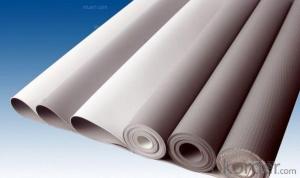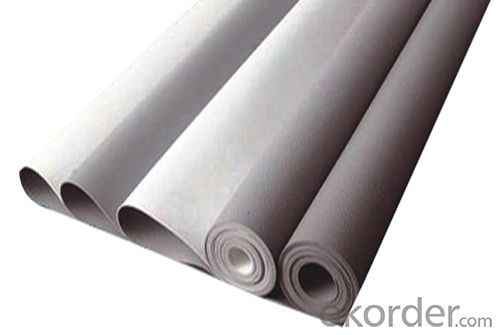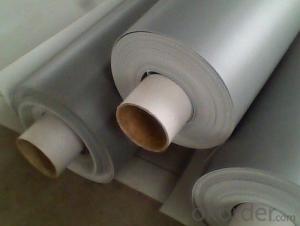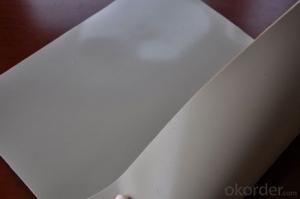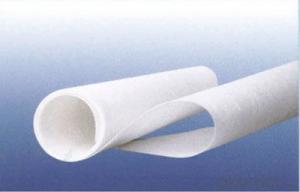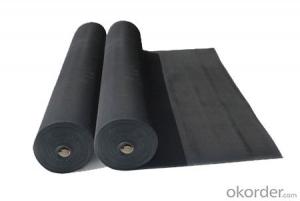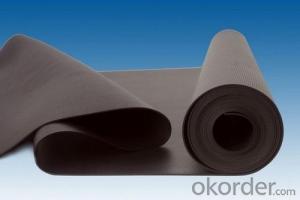Ethylene Propylene Diene Monomer Waterproofing Membrane
- Loading Port:
- China main port
- Payment Terms:
- TT OR LC
- Min Order Qty:
- 10000 m²
- Supply Capability:
- 300000 m²/month
OKorder Service Pledge
OKorder Financial Service
You Might Also Like
1.Structure of EDPM Waterproofing Membrane Description:
EPDM waterproofing membrane (hereinafter referred to as EPDM coiled material) system for EPDM mixed with just the right amount of butyl rubber, curing agent, accelerator, softener and reinforcing agent, end spacing refine, pull piece of filtering, extrusion molding process. Due to the molecular structure of epdm on the main chain of double bond, as a result, when it had been hit by ozone, ultraviolet radiation, the role of damp and hot, is not easy to break on the primary key, so it has excellent weather resistance, aging resistance, and high tensile strength, elongation, scaling or cracking at the base of strong adaptability, value, light weight, use temperature scope width (within the range - 40 ~ + 80 ℃ can use for a long time), is a kind of efficient waterproof material. It can also be cold construction, convenient operation, reducing environmental pollution, improve workers' working conditions.
2.Main Features of EDPM Waterproofing Membrane:
Excellent weather resistance and aging resistance
High tensile strength and high elongation break
High value,light weight
Easy operation, reducing environmental pollution
3.Specification of EDPM Waterproofing Membrane:
| Item | ||||
| Tensile Strength(Mpa) | 7.5 | Shrinkage ≤ | 4 | |
Elongation at failure (%) | 450 | |||
| Tear strength(KN/M) | 25 | |||
Low temperature bending(℃) ≤ | 40 |
4.EDPM Waterproofing Membrane Images:
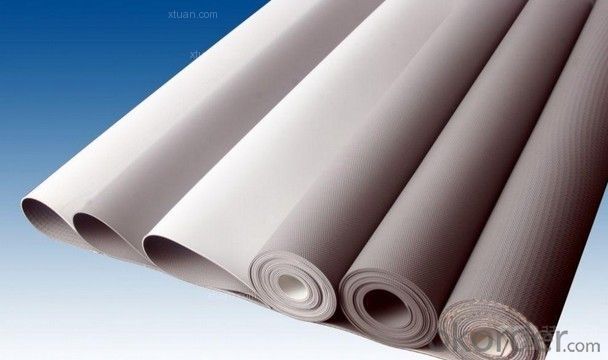
- Q: Can waterproofing membranes be applied in cold weather?
- Yes, waterproofing membranes can be applied in cold weather. However, it is important to consider a few factors when applying these membranes in low temperatures. Cold weather can affect the curing process of the membrane, potentially slowing it down. It is crucial to ensure that the surface being waterproofed is dry and free from ice or frost before applying the membrane. Additionally, some waterproofing products may have specific temperature requirements for optimal performance, so it is essential to consult the manufacturer's guidelines. In colder temperatures, it may also be necessary to use specialized adhesives or primers designed for cold weather applications. Overall, with proper precautions and the use of appropriate materials, waterproofing membranes can be successfully applied in cold weather.
- Q: Are waterproofing membranes resistant to mold and mildew?
- Waterproofing membranes exhibit resistance to mold and mildew in general. Their purpose is to establish a barrier against moisture, halting its infiltration into the structure and thwarting the growth of mold and mildew. These membranes are commonly crafted from materials like rubber, PVC, or bitumen, which do not foster the development of mold and mildew. Moreover, they are installed in a manner that guarantees effective drainage and ventilation, further diminishing the likelihood of mold and mildew formation. However, it is crucial to bear in mind that although waterproofing membranes significantly decrease the risk of mold and mildew, they are not infallible. It remains imperative to maintain adequate ventilation and promptly address any water leaks or damage to prevent the growth of mold and mildew.
- Q: Can a waterproofing membrane be used on metal surfaces?
- Yes, a waterproofing membrane can be used on metal surfaces. Waterproofing membranes are designed to protect surfaces from water penetration and can be applied to a variety of materials, including metal. These membranes are typically made of materials such as modified bitumen, EPDM, PVC, or TPO, which provide a durable and watertight barrier. Applying a waterproofing membrane to a metal surface can help prevent corrosion, rust, and water damage, making it a suitable solution for protecting metal structures, roofs, or surfaces that are exposed to moisture or water. However, it is important to ensure that the specific waterproofing membrane being used is compatible with the type of metal surface and that proper installation guidelines are followed for optimal performance and longevity.
- Q: Are waterproofing membranes resistant to earthquake movements?
- Waterproofing membranes are not specifically designed to be resistant to earthquake movements. Their primary function is to prevent water penetration and protect structures from moisture damage. While they may provide some level of resistance to minor ground movements, they are not intended to withstand the significant forces generated during earthquakes. Additional seismic design measures and materials are required to ensure structures can withstand seismic events.
- Q: Can a waterproofing membrane be used for a crawl space?
- Yes, a waterproofing membrane can be used for a crawl space. Crawl spaces are susceptible to moisture and water intrusion, which can lead to various issues such as mold growth, structural damage, and unpleasant odors. A waterproofing membrane can act as a barrier to prevent water and moisture from seeping into the crawl space. It is typically installed on the walls and floors of the crawl space, creating a watertight seal. This membrane can effectively prevent water from entering, making it an excellent solution for crawl space waterproofing. Additionally, some waterproofing membranes also have antimicrobial properties, further reducing the risk of mold and mildew growth in the crawl space.
- Q: Can a waterproofing membrane be used on precast plastic surfaces?
- Precast plastic surfaces can indeed benefit from the use of a waterproofing membrane. These membranes serve the purpose of establishing a shield against moisture and can be utilized on various surfaces such as concrete, metal, and plastic. By correctly implementing a waterproofing membrane, water infiltration is prevented, thus guaranteeing the long-lasting and resilient nature of the precast plastic surface. To ensure proper adhesion and effectiveness, it is crucial to select a waterproofing membrane that is compatible with plastic and adhere to the guidelines provided by the manufacturer during application.
- Q: Can a waterproofing membrane be used for underwater structures?
- Yes, a waterproofing membrane can be used for underwater structures. Waterproofing membranes are designed to provide a barrier against water penetration, which makes them suitable for use in underwater applications. They are commonly used in the construction and maintenance of structures such as swimming pools, submarines, offshore platforms, and underwater tunnels to prevent water leakage and protect against corrosion.
- Q: Can a waterproofing membrane be used for a parking garage deck?
- Indeed, a parking garage deck can benefit from the use of a waterproofing membrane. Its purpose is to safeguard the underlying structure by creating a barrier against water infiltration. Given the exposure of parking garage decks to various weather conditions and potential vehicle-related leaks, it is imperative to employ a waterproofing membrane to shield the concrete slab and prevent moisture-related problems such as cracking, corrosion, and deterioration. By implementing a waterproofing membrane on the parking garage deck, a protective layer is established, effectively blocking water from permeating the concrete. This membrane can be applied in the form of a liquid coating, sheet membrane, or a combination thereof. The selection of the appropriate membrane depends on factors including the desired level of protection, traffic load, and project-specific requirements. Moreover, a waterproofing membrane for a parking garage deck offers additional advantageous properties aside from water resistance. Some membranes are engineered to withstand chemicals and oil, which is vital considering the potential exposure to vehicles. Additionally, they provide an extra layer of defense against freeze-thaw cycles that may inflict harm upon the concrete structure. It is crucial to note that the installation of a waterproofing membrane for a parking garage deck should be carried out by experienced professionals who adhere to the manufacturer's guidelines and industry standards. Proper surface preparation, including thorough cleaning and repair of any cracks or defects, is imperative to ensure the long-term effectiveness of the membrane. In conclusion, a waterproofing membrane proves to be an effective solution for safeguarding a parking garage deck against water damage. It serves to prevent water infiltration, safeguard the concrete from deterioration, and enhance the overall durability and lifespan of the structure.
- Q: Can a waterproofing membrane be used in food processing or pharmaceutical facilities?
- Yes, a waterproofing membrane can be used in food processing or pharmaceutical facilities. Waterproofing membranes are designed to provide a protective barrier against moisture, which is beneficial in environments where hygiene and cleanliness are paramount, such as food processing or pharmaceutical facilities. By preventing water penetration, these membranes help maintain a dry, clean, and hygienic environment, ensuring the safety and integrity of the products being processed or manufactured.
- Q: Can a waterproofing membrane be used for a garden pond liner?
- Yes, a waterproofing membrane can be used as a garden pond liner. Waterproofing membranes are designed to prevent water penetration, making them an effective option for creating a watertight barrier in a garden pond.
Send your message to us
Ethylene Propylene Diene Monomer Waterproofing Membrane
- Loading Port:
- China main port
- Payment Terms:
- TT OR LC
- Min Order Qty:
- 10000 m²
- Supply Capability:
- 300000 m²/month
OKorder Service Pledge
OKorder Financial Service
Similar products
Hot products
Hot Searches
Related keywords
